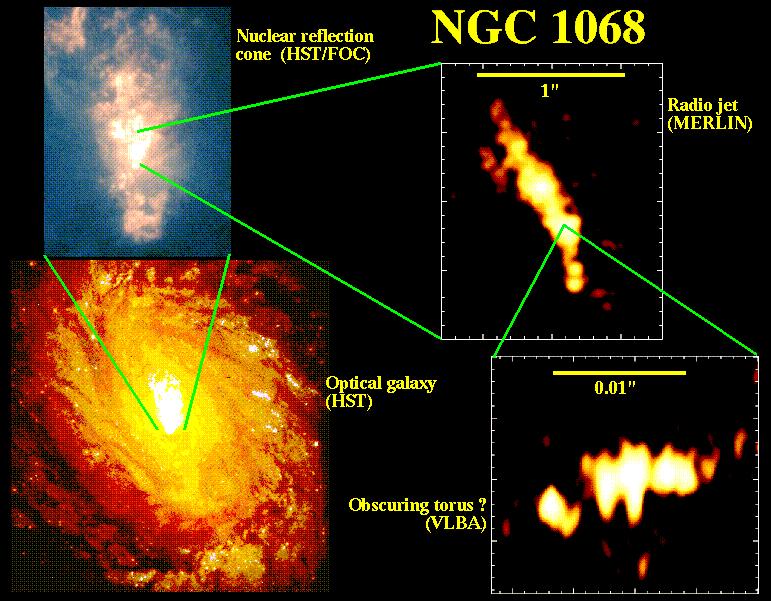stephen63 wrote:
Worst case scenario.....maybe.
So much for anything living in the nearby galaxy.
http://en.wikipedia.org/wiki/3C_321 wrote:
<<3C 321 is a system of two galaxies rotating around each other. They are notable for showing the first observed galaxy
SMITING another galaxy with a blast of energy, which is theorized to be from a supermassive black hole at the center of the former galaxy.
The larger galaxy, dubbed the "Death Star Galaxy" by NASA astronomers, has an energetic jet directed towards its companion. The discovery was announced by NASA Dec 18 2007. Observation of the enormous jet was possible due to the combined efforts of both space and ground-based telescopes.>>
- ..................................................................................
- King Lear Act 3, Scene 2, Line 1
- [Enter KING LEAR and 'Fool']
KING LEAR: Blow, winds, and crack your cheeks! rage! blow!
. You cataracts and hurricanoes, spout
. Till you have drench'd our steeples, drown'd the cocks!
. You sulphurous and thought-executing fires,
. Vaunt-couriers to oak-cleaving thunderbolts,
. Singe my white head! And thou, all-shaking thunder,
. SMITE flat the thick rotundity o' the world!
. Crack nature's moulds, an germens spill at once,
. That make ingrateful man!
..................................................................................
- The Merry Wives of Windsor Act 3, Scene 1
SIR HUGH EVANS. Well, I will SMITE his noddles.
..................................................................................
- Hamlet, Prince of Denmark Act 1, Scene 1
HORATIO: He SMOTE the sledded Polacks on the ice. 'Tis strange.
..................................................................................
- Coriolanus Act 3, Scene 1
SICINIUS: Our aediles SMOTE? ourselves resisted?
..................................................................................
- Love's Labour's Lost Act 4, Scene 3
. So sweet a kiss the golden sun gives not
. To those fresh morning drops upon the rose,
. As thy eye-beams, when their fresh rays have SMOTE
. The night of dew that on my cheeks down flows:
. Nor shines the silver moon one half so bright
. Through the transparent bosom of the deep,
. As doth thy face through tears of mine give light;
. Thou shinest in every tear that I do weep:
. No drop but as a coach doth carry thee;
. So ridest thou triumphing in my woe.
..................................................................................
- The Tempest Act 4, Scene 1
ARIEL: they were red-hot with drinking;
. So fun of valour that they SMOTE the air
. For breathing in their faces; beat the ground
. For kissing of their feet; yet always bending
. Towards their project. Then I beat my tabour;
. At which, like unback'd colts, they prick'd their ears,
. Advanced their eyelids, lifted up their noses
. As they smelt music: so I charm'd their ears
. That calf-like they my lowing follow'd through
. Tooth'd briers, sharp furzes, pricking goss and thorns,
. Which entered their frail shins: at last I left them
. I' the filthy-mantled pool beyond your cell,
. There dancing up to the chins, that the foul lake
. O'erstunk their feet.
..................................................................................
- Othello, The Moor of Venice Act 5, Scene 2
OTHELLO: Set you down this;
. And say besides, that in Aleppo once,
. Where a malignant and a turban'd Turk
. Beat a Venetian and traduced the state,
. I took by the throat the circumcised dog,
. And SMOTE him, thus.
---------------------------------------------------------------------------
SMITE, v. t. [imp.
SMOTH (?), rarely
SMIT (); p. p.
SMITTEN (?), rarely
SMIT, or
SMOTE; p. pr. & vb. n.
SMITING (?).] [AS. smītan to
SMITE, to soil, pollute; akin to OFries. smīta to
SMITE, LG.
SMITEN, D. smijten, G. schmeissen, OHG. smīzan to smear, stroke, OSw. & dial. Sw. smita to
SMITE, Dan. smiide to throw, Goth. bismeitan, to anoint, besmear; cf. Skr. md to be fat.
The original sense seems to have been, to daub on, to smear. Cf. Smut.]
1. To strike; to inflict a blow upon with the hand, or with any instrument held in the hand, or with a missile thrown by the hand; as, to
SMITE with the fist, with a rod, sword, spear, or stone.
- Whosoever shall SMITE thee on thy right cheek, turn to him the other also. Matt. v. 39.
And David . . . took thence a stone, and slang it, and SMOTE the Philistine in his forehead. 1 Sam. xvii. 49.
2. To cause to strike; to use as an instrument in striking or hurling.
- Profpesy, and SMITE thine hands together. Ezek. xxi. 14.
Saul . . . SMOTE the javelin into the wall. 1 Sam. xix. 10.
3. To destroy the life of by beating, or by weapons of any kind; to slay by a blow; to kill; as, to
SMITE one with the sword, or with an arrow or other instrument.
4. To put to rout in battle; to overthrow by war.
5. To blast; to destroy the life or vigor of, as by a stroke or by some visitation.
- The flax and the barely was SMITTEN. Ex. ix. 31.
6. To afflict; to chasten; to punish.
- Let us not mistake God's goodness, nor imagine, because he SMITES us, that we are forsaken by him. Wake.
7. To strike or affect with passion, as love or fear.
- The charms that SMITE the simple heart. Pope.
SMITH with the love of sister arts we came. Pope.
 Nearby Spiral Galaxy NGC 4945
Nearby Spiral Galaxy NGC 4945
